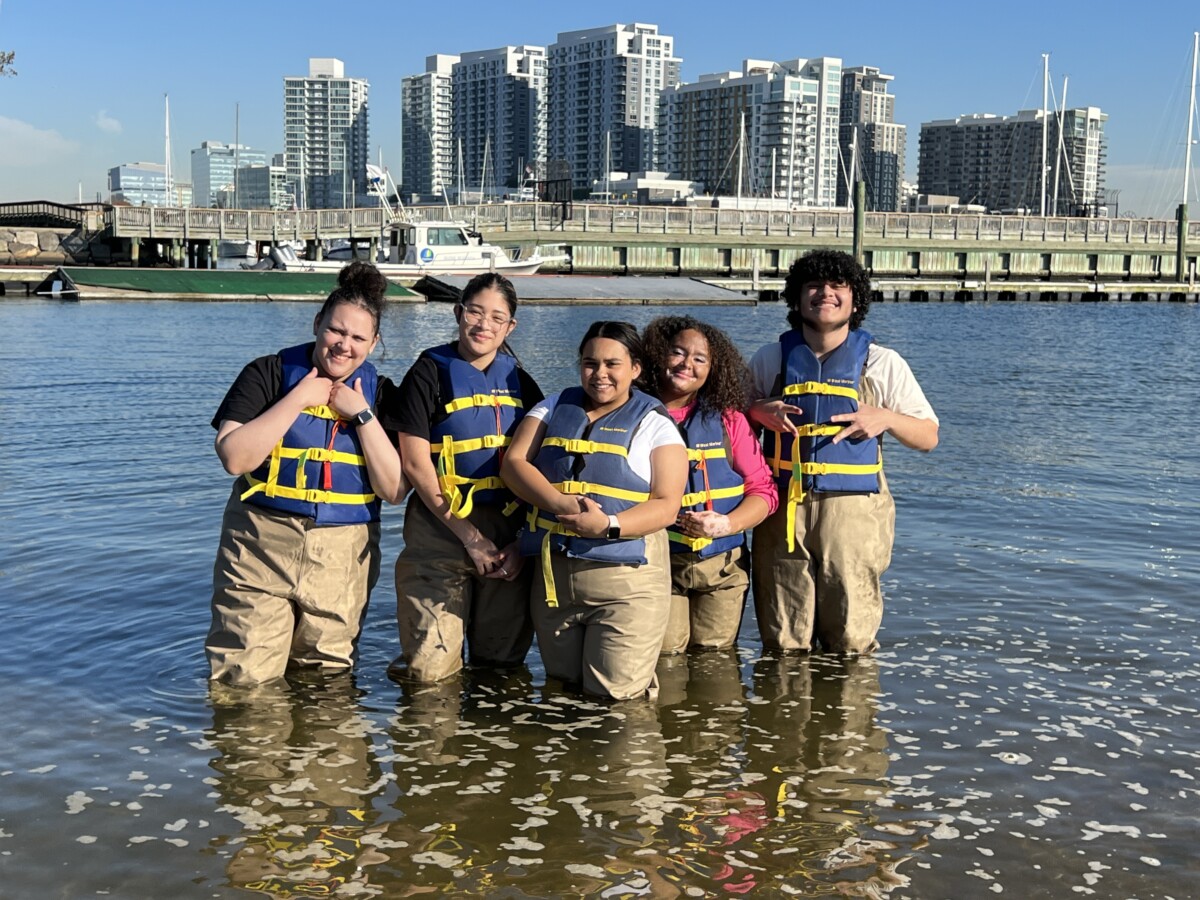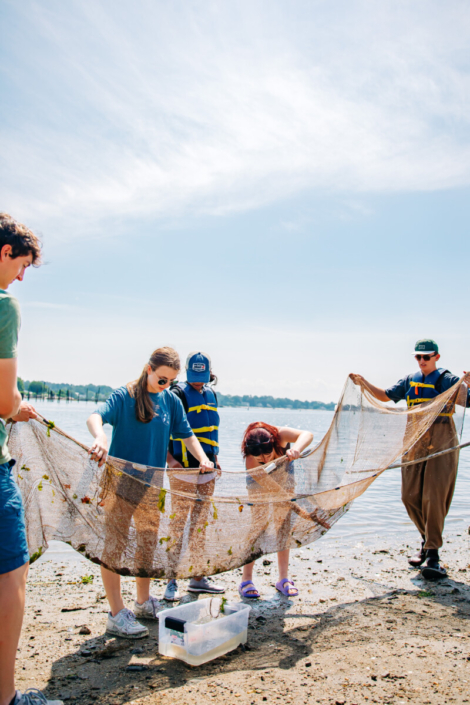SoundWaters Field Visits
Students studying with SoundWaters will gain a deep understanding of the function of the Long Island Sound Watershed. They will gain firsthand experience on how upstream populations can have large impacts on downstream processes and ecosystem health. Through hands-on study, students will have exposure to field methods and gain a greater understanding of the connection they have to the Long Island Sound Watershed, as well as the habitats and organisms of Long Island Sound to one another. Students will also gain insight on climate change and the ways in which it impacts and shapes the Long Island Sound, from species composition to dissolved oxygen content.
Rocky Intertidal Zone Analysis:
Long Island Sound’s rocky intertidal zone is a complex, critical, and diverse ecosystem. Its inhabitants are challenged by invasive species that compete for resources and parasitize native species. In this activity, students will conduct research on species diversity and characteristics to conduct a baseline assessment on the rocky intertidal zone.
Marine Debris Survey:
Nearly 9 million people live within the Long Island Sound Watershed, in such a densely populated area manmade debris has large impacts on the shorelines. Students will study what debris is being deposited on the beach and how to categorize/assess that debris. Students will learn how to create a transect and collect marine debris to assess pollution impact on the sandy shore of Long Island Sound.
Shoreline Seining Survey:
Shallow embayments like Stamford Harbor provide important refuge for both juvenile and forage species of animals. Students will utilize 25’ seine nets to sample the relative abundance of forage species, invertebrate species, and other important recreational finfish. Students will also learn to identify species and their significance in the local ecosystem.
Plankton Population Assessment:
Plankton play the critical role of producing nearly half the world’s oxygen and form the base of the largest food chain in the world. Students will discover which species of phytoplankton and zooplankton comprise Stamford Harbor’s plankton population. Utilizing plankton nets students will gather samples from the Harbor, the samples will be assessed with a combination of stereomicroscopes, and dissecting microscopes. Students will learn to utilize a dichotomous key to aid in identifying organisms to the species level.
Water Quality Analysis:
Water quality in the Long Island Sound faces the challenge of both climate change and human impact due to the dense nature of our watershed. Students will analyze the quality of the water in Stamford Harbor and assess differences between surface and bottom water. Students will deploy a multi-parameter sonde and take surface and bottom samples in Stamford Harbor taking note of site conditions and differences in water quality. Students will also utilize manual tools to take water quality and draw comparisons between different equipment.
Macrofauna in the Watershed:
Long Island Sound is full of animals with fascinating traits evolved to suit their unique environment. Students learn about and interact with the larger animals supported by the rich Long Island Sound Watershed. Students will learn how evolution, natural selection, and the environment play roles in shaping animals’ adaptations.
Schooner Sails – Science on the Sound
Students coming aboard the 80’ Schooner SoundWaters learn not just from Long Island Sound but while sailing on top of it. Students gain a fundamental understanding of marine biology field work pertaining to water quality, benthic population assessments, sediment sampling, and bird surveys. Students work as a team to raise the sails and harness the renewable wind power along the shores of Long Island Sound.
Water Quality Analysis:
Water quality in the Long Island Sound faces the challenge of both climate change and human impact due to the dense nature of our watershed. Students will analyze the quality of the water in Stamford Harbor and assess differences between surface and bottom water. Students will deploy a multi-parameter sonde and take surface and bottom samples in Stamford Harbor taking note of site conditions and differences in water quality. Students will also utilize manual tools to take water quality and draw comparisons between different equipment.
Benthic Macroinvertebrate Surveys:
Often unseen, the bottom sediment of Long Island Sound is full of life critical to nutrient cycling. Students will utilize two different styles of benthic sediment grabs (Ponar & Van Veen) to conduct assessments on macroinvertebrates living in the sediment. While underway students utilize a series of sieves to sift through their sediment samples. Under the guidance of educators, students work through benthic sediment samples identifying organisms that inhabit the benthic zone.
Long Island Sound Benthic Trawl Assessment:
Climate change has significantly altered the composition of fish species living in Long Island Sound. The best way to assess benthic communities is through trawling. Students will be introduced to the concept of trawling for scientific purposes and the functionality of a trawl net, after conducting the trawl students pull the net aboard. Students learn to measure and handle the animals, and further make an assessment based on whether the animals are categorized as warm or cold adapted species.
Raising the Sails:
Under the command of the captain of the Schooner SoundWaters students raise the sails and utilize the renewable power of wind. Students receive an introduction to sailing and its importance to the region.
Birds of Stamford Harbor:
Over 400 species of birds call the shores of Long Island Sound home throughout the year. Students will have access to binoculars and guides of shoreline species of birds and learn about the adaptations that make them uniquely suited to their environment.
In-School Visits
For when you can’t bring the class to Long Island Sound, let SoundWaters bring it to your classroom. Through hands-on activities students gain a deeper understanding of challenging topics like natural selection, evolution, hydrology, anatomy & physiology, microscope skills, and more.
For questions and to customize a program for you and your students please contact education@soundwaters.org.
Freshwater Benthic Macroinvertebrate Study:
Many invertebrate species in rivers spend much of their life in immature stages along the riverbed. These invertebrates can be used to make assessments on the quality of water in rivers due to their varying tolerance levels to pollutants. Students will conduct an assessment on an urban river, and a forested river based upon the different taxa of macroinvertebrates found in each sample. Students will become familiar with bioindicators, and dichotomous keys for identification purposes.
Macrofauna in the Watershed:
Long Island Sound is full of animals with fascinating traits evolved to suit their unique environment. Students learn about and interact with the larger animals supported by the rich Long Island Sound Watershed. Students will learn how evolution, natural selection, and the environment play roles in shaping animals’ adaptations.
Watershed Sediment Filtration:
Large portions of the natural surfaces of the Long Island Sound watershed have been replaced with impervious ones. This change has led to an increase of runoff and a decrease in the amount of sediment filtered water. In this activity students are challenged to design their own filters utilizing natural materials to improve a polluted water sample.













